Miniature roses are neat little plants, like somebody turned a shrink-ray on a full-sized rose and put it in a pot. They’re not easy to keep alive indoors – unless you give them what they need. Once you can give them the right amount of light, water, and fertilizer, along with a couple of other factors, you’ll be able to enjoy your little rose all year long.
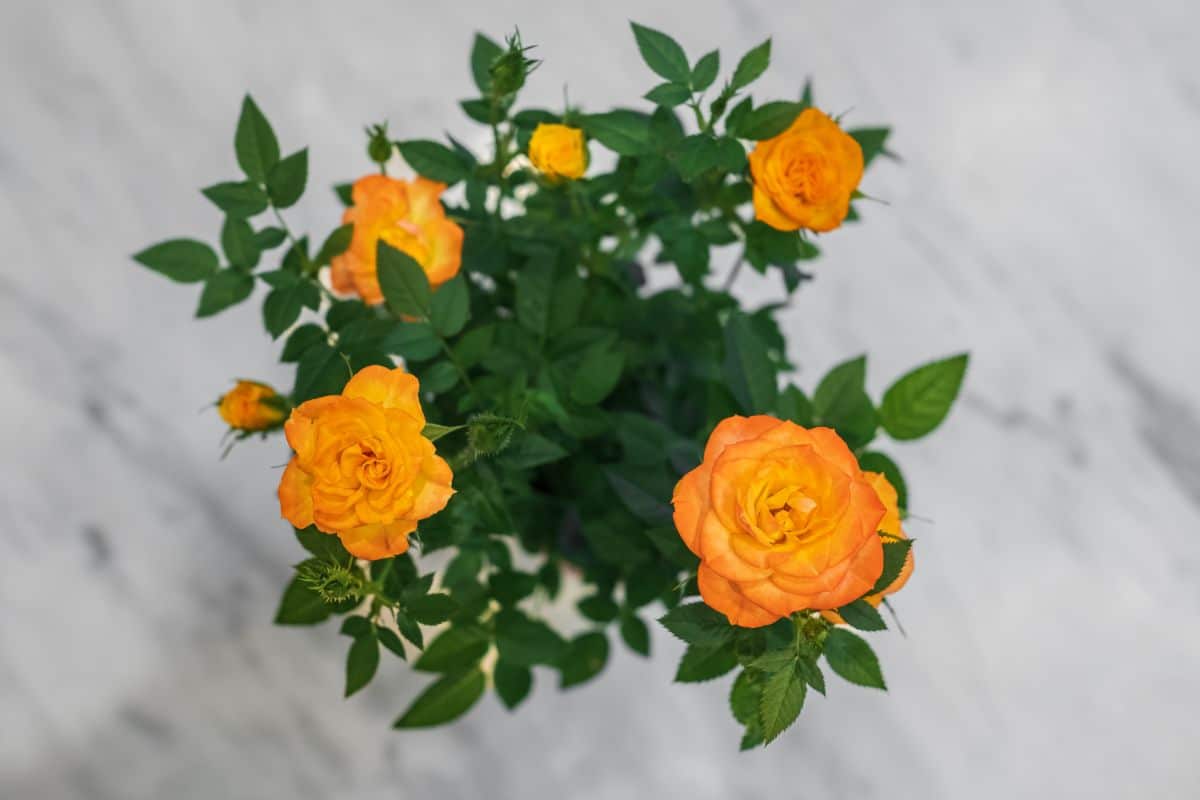
Jump to:
- Note: Some Miniature Roses Are Absolute Divas
- Miniature Roses Are Grown Exactly Like Outdoor Roses
- Where to Get Mini Roses
- How to Make Miniature Roses Bloom
- A Windowsill Might Not Be Enough for a Rose
- Mini Roses Bloom Most Reliably with a Grow Light
- Darkness is Necessary, Too
- What Does a Miniature Rose Need?
- Watering
- Deadheading
- Humidity and Temperature
- Target Insect Pests
- Common Rose Diseases
- Give Them the Outdoors When It’s Warm
- Bring The Rose Back Indoors After Its Dormant Phrase
Note: Some Miniature Roses Are Absolute Divas
There will be some miniature roses that will refuse to grow or prosper, whatever you do for them. Don’t feel bad about it. Some mini roses were bred merely for looks and beauty, not for vigor or strength. Sometimes, you’ll try to do everything you can to keep the rose alive, but you still lose the plant. Cut yourself some slack. Plants are living things and can be just as contrary as we are.
Miniature Roses Are Grown Exactly Like Outdoor Roses
Miniature roses have the same cultural requirements as regular roses.
- Full sun
- Medium to high humidity
- Air circulation
- Regular fertilization
- Proper watering (and no soggy, boggy conditions).
The big plus to indoor growing is that you have a lot more control over the environment. However, the big drawback to growing roses indoors is not knowing how to control the environment to successfully meet the rose’s needs.
That’s what this article is going to fix. Your indoor roses could potentially look better than your outdoor roses.
Where to Get Mini Roses

Online retailers and local grocery stores have them, though your best bet is with a local nursery. It’s better to support local businesses instead of some big corporation headquartered a zillion miles away. Also, the people at the local nursery know their plants and can answer your questions.
If you’re something of a rose pro, you can buy miniature roses from nurseries that specialize in roses, such as High Country Roses, Mountain Valley Growers, and Chamblee’s Rose Nursery. Then, you get quality roses and support a small business.
Pro Tip: Buy only potted miniature roses – never seeds. Even if the seeds do germinate, which usually they don’t, they will not grow true to type. Rose seeds are an exercise in frustration, heartbreak, and hellfire. And I’m saying this as a former horticulturist!
Read more: 12 Rules for Giving Plants as Gifts (+ Tips)
How to Make Miniature Roses Bloom
Miniature roses can be a little demanding. Here is what you need to do to keep your rose alive and hearty.
A Windowsill Might Not Be Enough for a Rose
Roses need full sunlight – and miniature roses especially require high light energy. This is their top need. Forming blossoms pull a lot of energy out of the rose, and they need strong light so their photosynthesis factories can crank out that energy.
A winter windowsill might look like it offers sufficient light. After all, the sun is hanging low in the south, so there’s more light coming in than there was in summer. Right?
Not quite. The reason the sun is so low is because our part of the earth is slanted away from the sun – farther away from its warming rays. So sunlight intensity has decreased – and is made worse by all those lousy cloudy days.
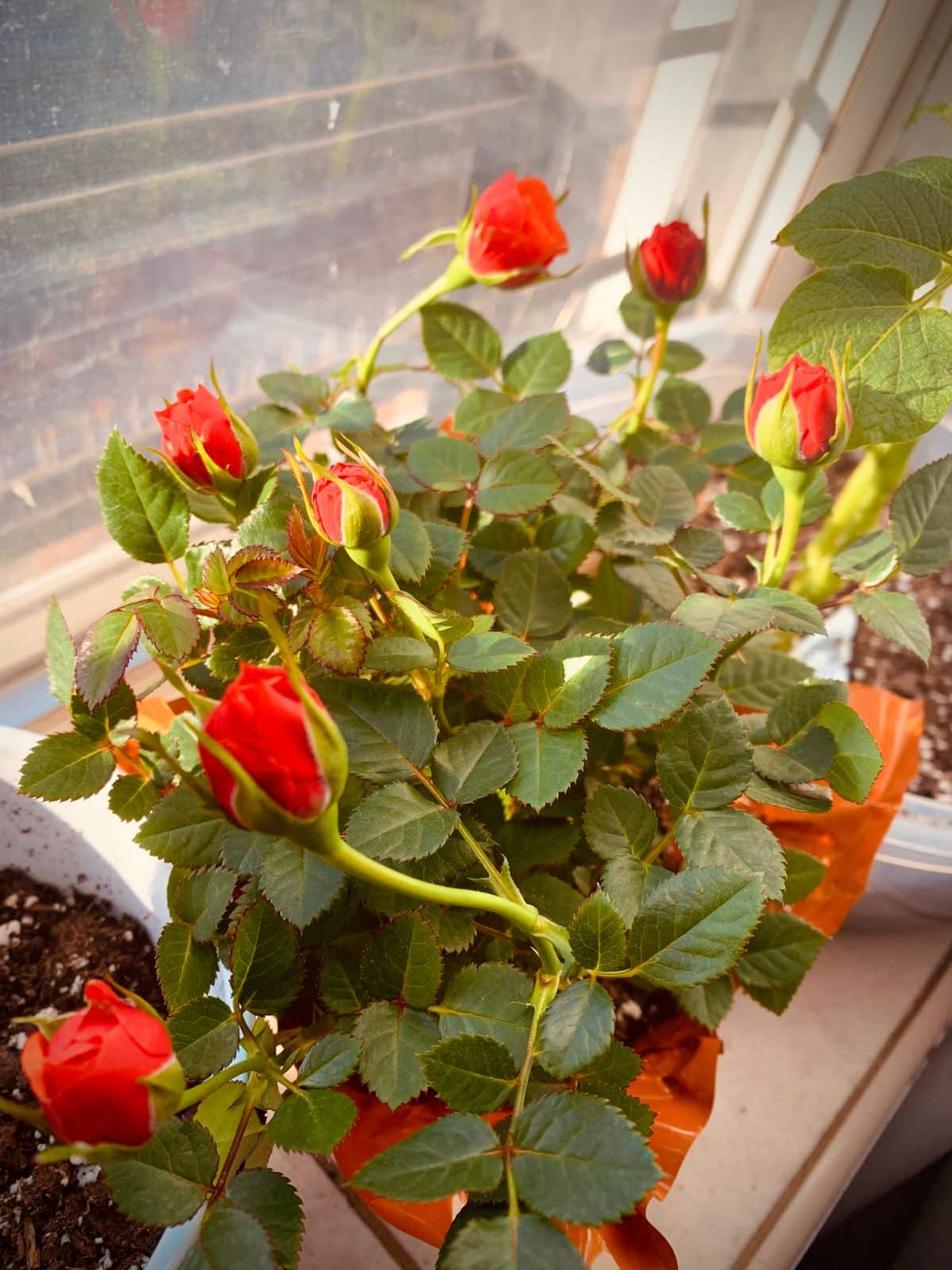
Not only that, but a miniature rose in the window will follow the cues the sun gives it, just as the rose bushes outdoors do. As spring comes on and days get longer, miniature roses will respond by putting out new leaves and forming blossoms, just as the outdoor roses do. As days get shorter in the fall, your miniature rose will respond by dropping all their leaves and flowers.
A window is great for many houseplants. But to live its best life, a miniature rose also needs a grow light.
Read more: Choosing the Right Grow Light
Mini Roses Bloom Most Reliably with a Grow Light
A high-quality, full-spectrum grow light is the most important thing you can get for your rose. A full-spectrum light is a white light that mimics natural sunlight and emits the color spectrum.
- These lights are good for plants and people alike.
- They keep the home bright and cheery when the outdoors is as gloomy as the grave.
- They can help against seasonal depressive disorder.
- They give the rose the parts of the color spectrum that it needs.
Full-spectrum light uses different parts of the light spectrum to have different effects on plants.
- Red light wavelength – This is the most efficient light for photosynthesis and plant growth.
- Blue light wavelength – Improves growth, keeps plants compact, and increases leaf color.
- Green light wavelength – Penetrates into leaves to improve photosynthesis.
- Other spectrums – The yellow, orange, and violet wavelengths play smaller, but still important, parts in photosynthesis.
Grow lights come in different styles and strengths. Decorative grow lamps put your miniature rose on display in your living area. Tabletop plant lights can give the rose full-spectrum light, look good, and they’re easy on the power bills.
LED lights are the most commonly used in grow lights. Cool-white fluorescent lamps will provide the red and blue light that roses need for foliage development, while the warm-white fluorescents provide the red and far-red light energy needed for deepened color in the flowers. Get the best of both worlds by using both colors to illuminate your miniature rose.
When growing a rose under light, rotate the plant every week to give all sides of the rose the same amount of light. This gives you a fuller, more symmetrical plant.
Darkness is Necessary, Too
Roses need 12 hours of grow light daily and 14 hours when they’re blooming. But miniature roses also need their hours of darkness as much as they need light. The night is when plants process the food they make during the day.
Darkness is necessary for flowering, too. Studies show that a steady succession of light and dark intervals is what triggers flowering – not light intensity or temperature. So give your miniature rose a reliable routine as far as when the lights turn on in the morning and when they shut off for the night.
Some grow lights are available with a timer. If yours aren’t, just do this the old-fashioned way by trudging around the house just before bedtime, turning off all the lights and grumbling, “Who left these lights on? Does anybody know how much electricity costs these days?”
Use an Old Aquarium as a Miniature Greenhouse

If you have an old aquarium that’s collecting dust, put your rose and other houseplants in it, and use the full-spectrum light that is in the lid to shine on them. You can even use it as a terrarium and make a little landscape in there. Set up a small fan nearby to keep the air circulating to avoid fungal diseases on your rose.
What Does a Miniature Rose Need?
Watering
The inevitable result of growing plants under strong lights is that plants will need watering more often. If the surface of the soil is drying out, check ¾ to 1 inch into the soil. If it’s dry below, too, then water your rose until water runs out through it.
The Problem with Decorative Plant Sleeves
Many plants sold at the florist or grocery store will be inside a plant sleeve or pot cover, which is a decorative cellophane wrapper that hides the plastic pot and keeps water from getting all over the place.
Sometimes, the sleeve hides the rose foliage, which keeps it from getting the light it needs.
But the bigger problem is that, often, people watering the plant don’t notice the excess water collecting inside the sleeve. Out of sight, out of mind, right?
This accumulating water can cause big problems.
- A rose with submerged roots develops root rot.
- As the roots die, the rose wilts.
- The rose owner sees the rose wilting and grabs the watering can.
- The rose gets more water!
It’s a vicious cycle.
So be mindful of the decorative sleeve. Cut it back so it covers only the flowerpot so light can reach the foliage. The sleeve makes a colorful saucer to catch excess water – which you will dump out after watering.
Deadheading
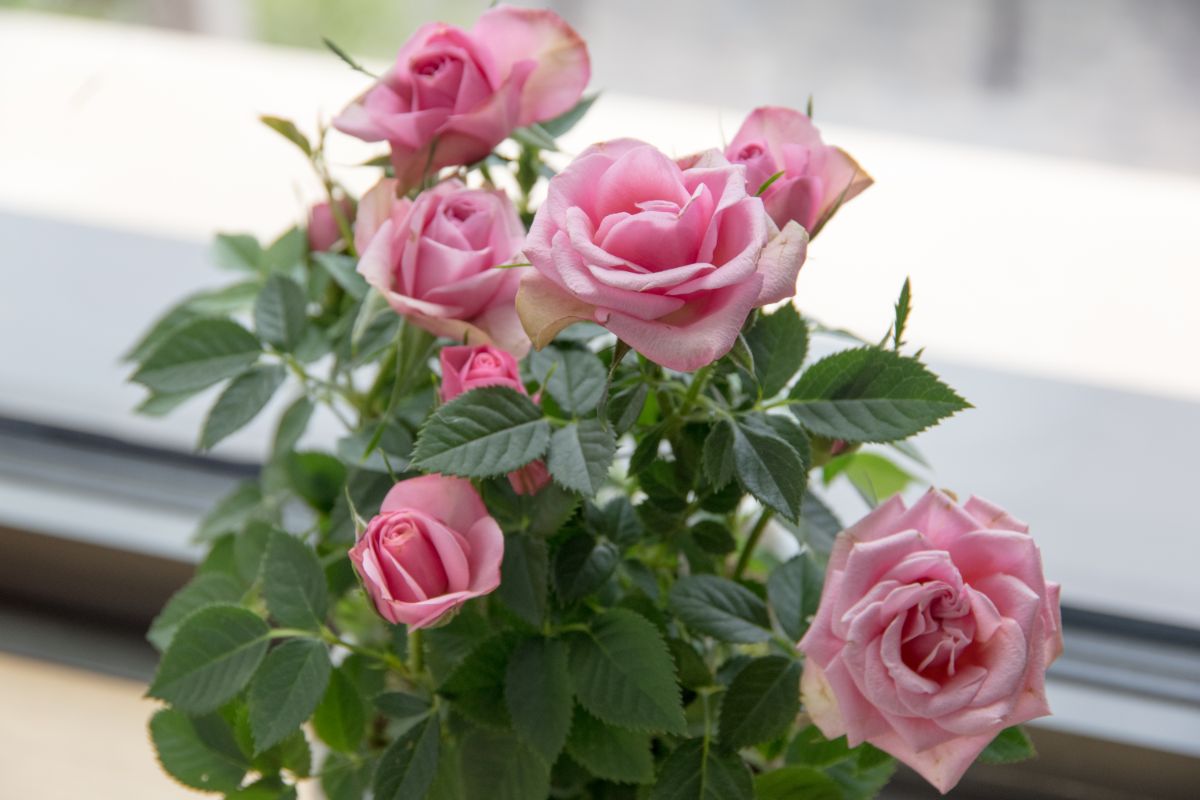
Deadheading doesn’t mean playing Grateful Dead albums for your rose. It means snipping off the blossoms when they start losing petals and falling apart. Look at the stem. Below the dying flower is usually a new bud beginning to leaf out. Snip off the stem just above this bud. This encourages new growth.
Good hygiene is important to roses. Remove yellowing or dead leaves and stems.
Read more: 5 Best Humidifiers for Houseplants + DIY Ways to Humidify
Humidity and Temperature
Miniature roses like humidity at about 50 to 55%. In winter, these numbers are harder to reach, as the average home humidity hovers at 15 to 20% – comparable to that of the Sahara Desert. Counteract that by running a humidifier.
Day temperatures should be in the low 70s, while night temps ought to be in the low to mid-60s. The warmer day temperature helps the rose make food, while the cooler night slows the rose down so it can use it.
Target Insect Pests
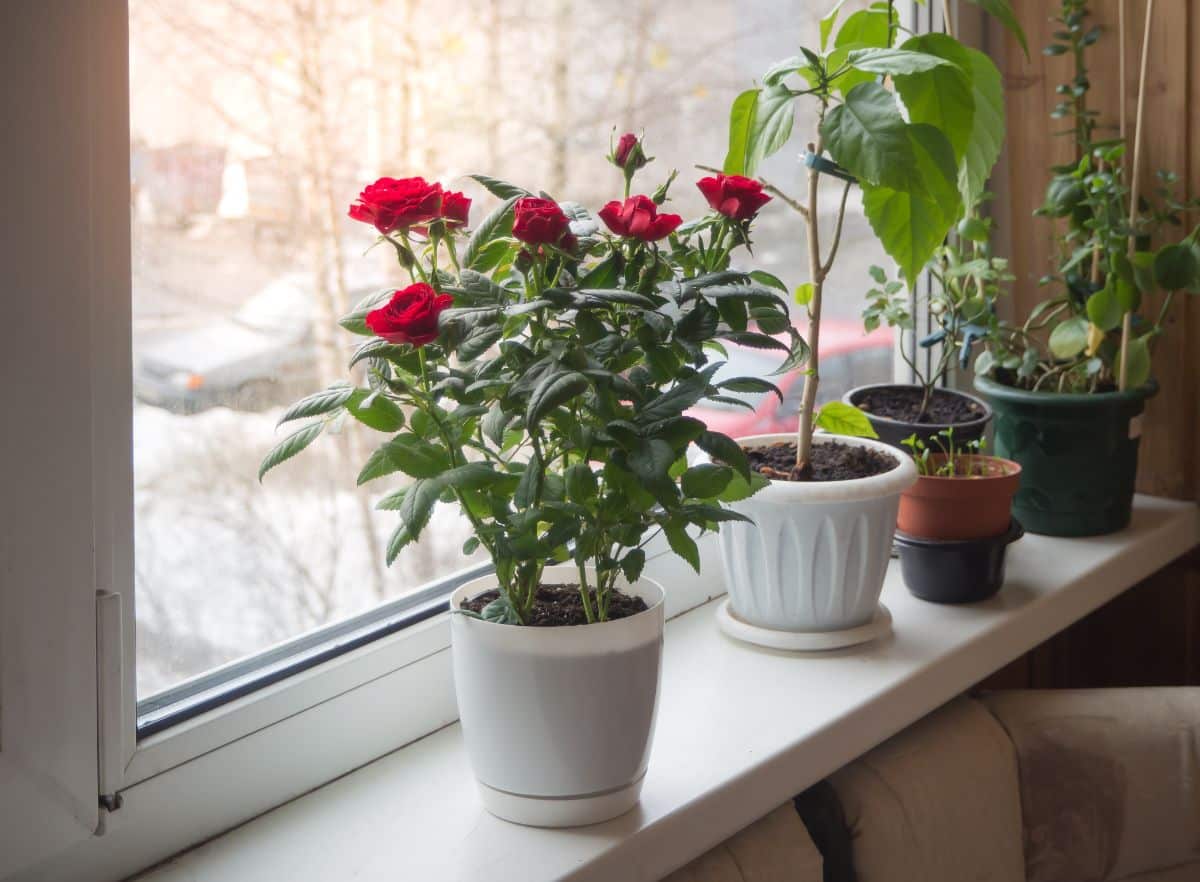
Be sure to check the rose often for signs of pests and diseases. Even if there are no other plants in the house, check them anyway. Some miniature roses are like sponges, soaking up any disease within a five-mile radius. It’s a decidedly unhelpful trait.
Read more: How to Kill Aphids and Soil Gnats with Homemade Vinegar Spray
Spider mites often target indoor roses, as well as mealybugs, whiteflies, and aphids. Pests will make themselves known by leaving a sticky, sugary substance called honeydew on the leaves (aphids) or by spinning tiny white webs on the leaves and stems (spider mites), appearing on the plant like tiny bits of waxy fluff (mealybugs) or by flying up from the plant like tiny white flies (whiteflies).
If any signs of pests show up on your miniature rose, don’t panic. First take your rose out of its saucer and set it in the kitchen sink or a work sink. Then, use the sink sprayer to wash the rose. Spray well underneath the leaves and inside the plant. Pour a little soapy water over the plants to kill the insects or wash them away.
Read more: Proven Ways to Kill Mealybugs on Houseplants
Common Rose Diseases
A rose prefers medium to high humidity, but when the air is stagnant and unmoving, fungal diseases can form.
Blackspot is a common bugbear of roses, causing black spots to develop on the surface of the leaves, which soon turn yellow and fall off.
Powdery mildew turns the leaves white as if they’ve been dusted with talcum powder, but this stuff doesn’t rub off.
A good way to prevent these diseases is to spray the miniature rose with a solution of one part milk to two parts water. Put this in a small spray bottle, add a drop or two of soap, then spray the rose with it every week. Don’t let any unused solution sit around for a week, obviously, because it will congeal, so use a new solution. You won’t need much since the rose is so small.
Milk is a preventative measure, not a cure. Any time you find infected leaves, remove them and squish any insects you see on the rose.
Give Them the Outdoors When It’s Warm
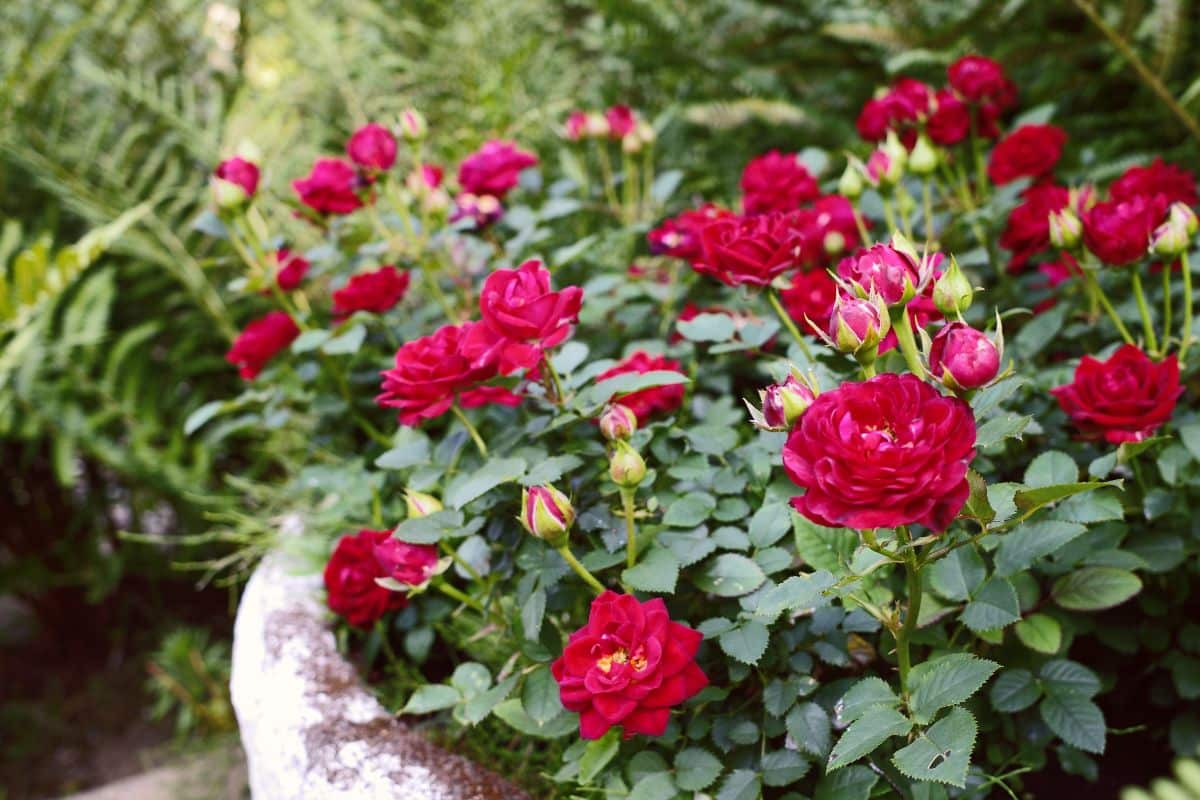
Once all chance of frost is gone, you can move your miniature roses outside to enjoy the summer sun. Put it in a protected area with bright shade for a week so it can get acclimated to the sun. After that, place it in a sunny spot.
If you’re really bad about watering your outdoor plants, bury the whole pot in the ground to keep it from drying out. However, if your area is prone to slugs or snails, put it in a decorative container so they don’t eat it up overnight.
Give your outdoor roses a generous layer of mulch, whether they’re in a pot or in the ground. I’m a rosarian, and I’ve seen with my own eyes how a rose will perk up when it gets mulch, especially in summer when it’s hot and cloudless and refusing to rain.
Bring The Rose Back Indoors After Its Dormant Phrase
The miniature rose can stay outside until frost. Let it go dormant, cover it with mulch once it has acclimated to the cold for about a month, and let it have its dormant period. In January, bring it back inside and slowly acclimate it to the warmth of the indoors. Fertilize and water the miniature rose and give it light once again to force it to leaf out and bloom.


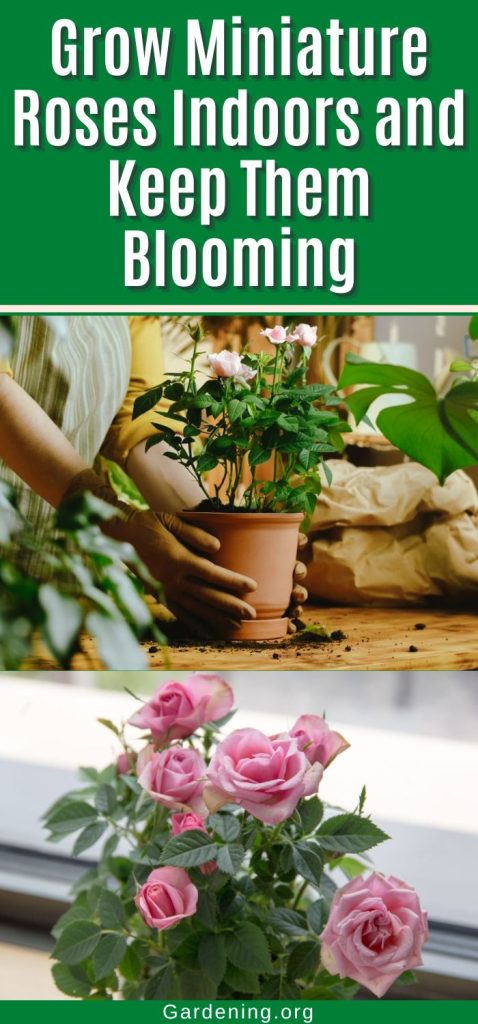
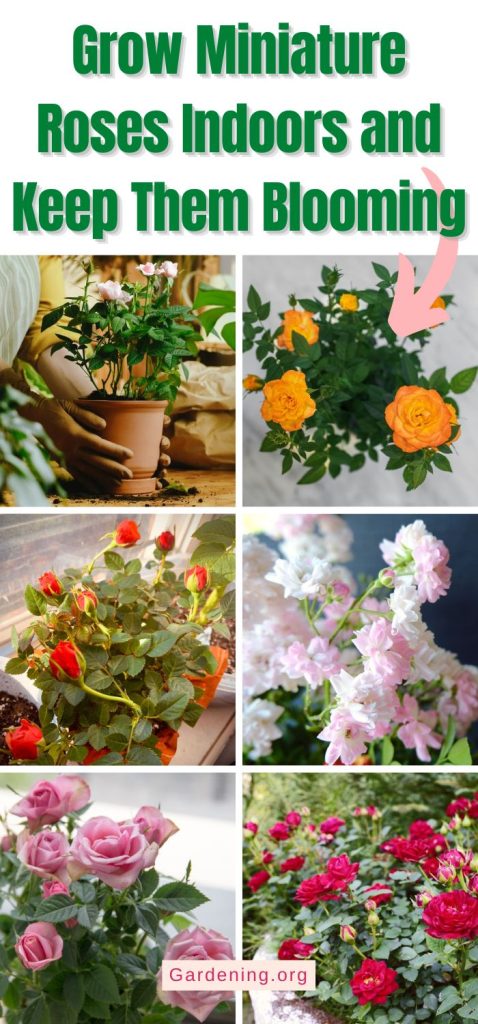
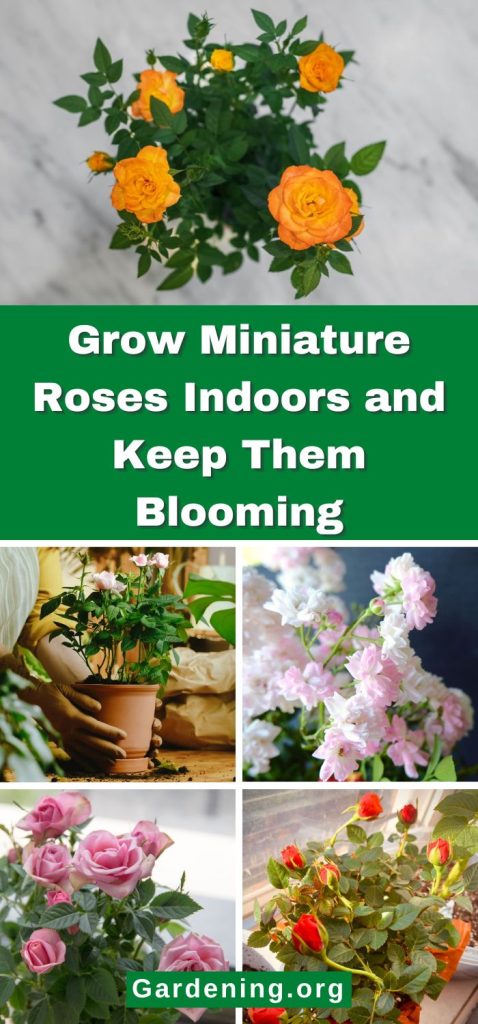




Leave a Reply